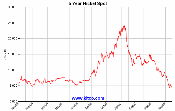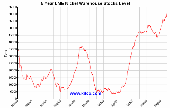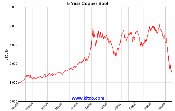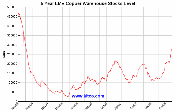 Market watchers have long considered MSM overuse of finance buzzwords as contrarian indicators. For instance, if every single media outlet in mid-2000 was crowing Dow 36,000 and how dot-com would change everything, savvy investors knew it was time to sell. We kicked off the latest buzzword watch here at Global Finance Net with our D-Watch yesterday and not even 24 hours later we have a decent list of “D” words buzzing around the Internet and the MSM, but is it a contrarian indicator this time?
Market watchers have long considered MSM overuse of finance buzzwords as contrarian indicators. For instance, if every single media outlet in mid-2000 was crowing Dow 36,000 and how dot-com would change everything, savvy investors knew it was time to sell. We kicked off the latest buzzword watch here at Global Finance Net with our D-Watch yesterday and not even 24 hours later we have a decent list of “D” words buzzing around the Internet and the MSM, but is it a contrarian indicator this time?
Today’s News, Brought to You by the Letter D
Two of today’s most prominent financial and economic luminaries were in full D-Watch mode today. Nouriel Roubini started with a post at RGE Monitor titled “The Deadly Dirty D-Words [1]”. Not to be outdone, Nobel Prize winning economist (and contemporary of Fed Chair Ben Bernanke) Paul Krugman met Roubini D for D in the New York Times with “The Lame Duck Economy [2]”.
I. Like Two Ds in a Pod
Krugman and Roubini’s works fit together perfectly. Krugman articulates a warning I alluded to at the end of my post on the failure of the Treasury’s bailout plan (see, Paulson: Our TARP Has the Blues [3]). The warning is that there is precious little time to act on the global financial crisis and policy dithering until the Obama Administration can take over on January 20 may prove disastrous.
Roubini follows Krugman perfectly with a doable policy outline that can be acted upon immediately. Like him or not Roubini, a.k.a. “Dr. Doom”, has an impeccable track record calling this crisis and his advice should be taken very seriously.
Getting back to D-Watch, the trends both authors noted in their articles were:
- Deflation (Krugman and Roubini)
- Debt (Roubini)
- Defaults (Roubini)
- Detroit (Krugman)
II. Deflation is the Demon we Despise
Our last post discussed the Roman Empire’s Crisis of the Third Century [4] and the post-crisis events that eventually led to the fall of Rome two centuries later. The Crisis was a classic inflationary-deflationary trap where money supply was at first inflated, then a deflationary spiral crashed everything. Our current situation is not so different:
- Alexander Severus devalued Roman currency to pay for his wars, as Alan Greenspan let M3 explode to inflate the housing bubble.
- Asset and commodity prices in the Roman Empire went up in nominal terms as did housing and commodities in the U.S. (though in real terms, think of these assets relative to wages or Euros, real asset values were beginning to deflate).
- Once all saved value had been leveraged in to debt asset prices ceased inflating and started to deflate in nominal terms (not just real).
III. D-Watch Plays Heavy Metal
We can see, if you will pardon my use of the term, depression signs in the spot trading for two base metals, nickel and copper. It goes without saying that Ni and Cu are used in just about every product we buy, so a sharp turn in their markets is not a good economic sign.
Nickle Prices Fall, LME Stocks Back Up
The two charts below from Kitco Base Metals [5] show the drop in demand pressures on the nickel market.
 [6] [6] |
 [7] [7] |
The price chart illustrates the sharp fall in price from the 2005-2007 bubble, while the LME stocks chart shows more room for a further price drop due to build-up in supply.
Copper Prices Fall, Stocks Better Off
The copper market is a bit healthier than Nickel, though we should remember that copper was in such short supply it was not uncommon to hear stories of copper cable theft. I haven’t heard any of those stories recently.
 [8] [8] |
 [9] [9] |
IV. What to D-do about D-flation in D-cember?
Remember that D-Watch is still about looking for a Depression, not deflation, which would be just one element of a Depression. As I have stressed and as Krugman and Roubini seem to say, policymakers have precious little time. Here is why action is needed now and why deflation needs to be taken very, very seriously:
- Almost all policy remedies fail in case of deflation. Monetary policy fails, only fiscal spending has any hope of curing deflation. There is no trade policy, private sector remedy, invention or movement that can stop deflation, except massive spending or all out war.
- All of the buy gold, treasuries, silver, and so on as a safe haven is meaningless in deflation. There are no financial safe havens in a deflation.
- Note from point 1 as to how deflations were cured in the past. In Rome’s case it was division of the Empire and war, in Russia’s case it was spending from the oil price boom during the early 2000s, in the case of the Great Depression it was a combination of the New Deal and WWII.
I must stress that the key point here is to heed Roubini and Krugman’s advice, policymakers cannot afford to wait until January 20. For individuals, please read my Terms of Use as nothing here is meant as a specific recommendation. You should always consult with your financial/legal advisor and consider your own situation.
(N.B.: I have purposely kept the number of links in this post low as Global Finance Net has been having problems updating in Blogger and Technorati search engines. Apparently, blogs with high numbers of links are flagged as spam blogs, so let’s see if lowering our links helps at all. Grrrr.)
. . . And that’s how it goes